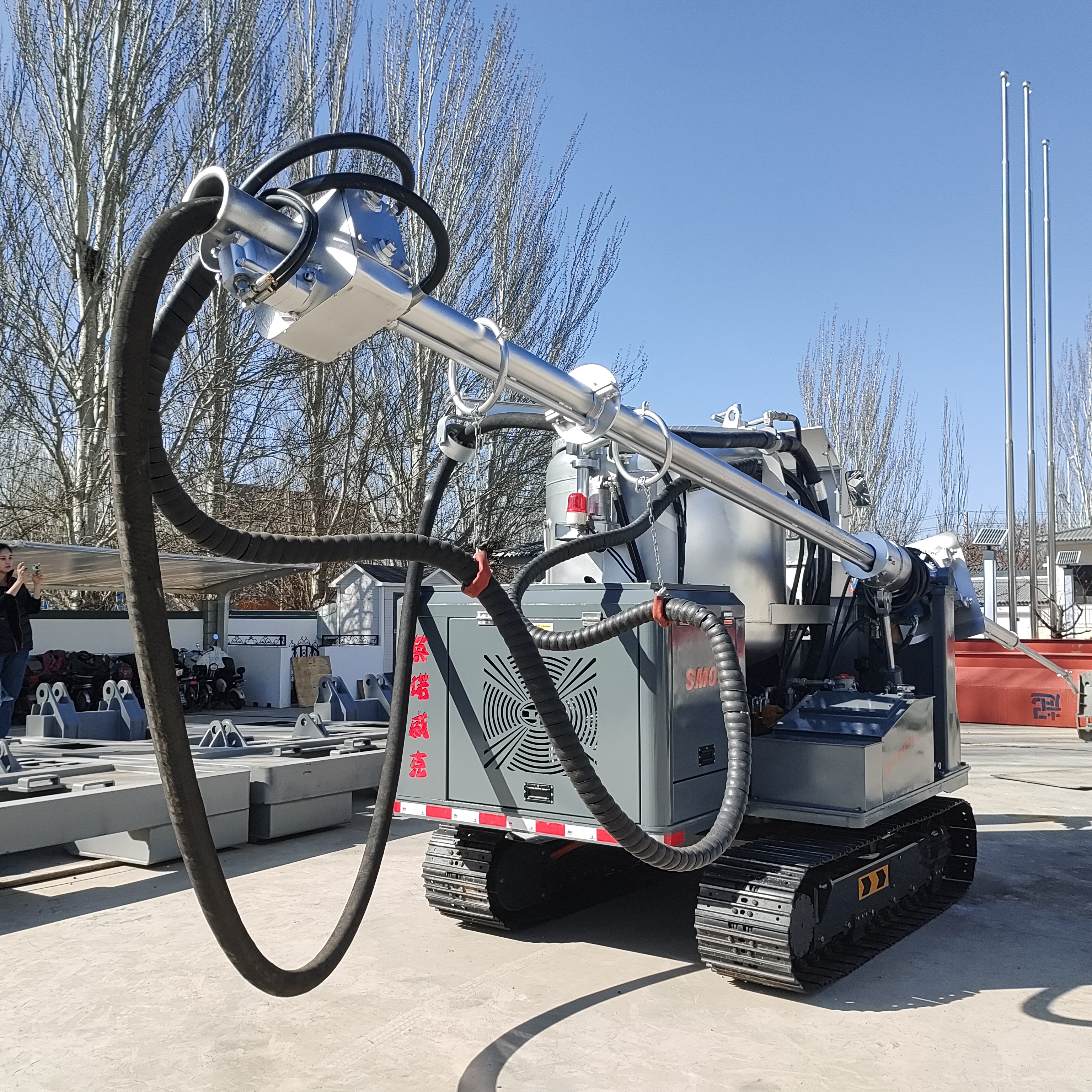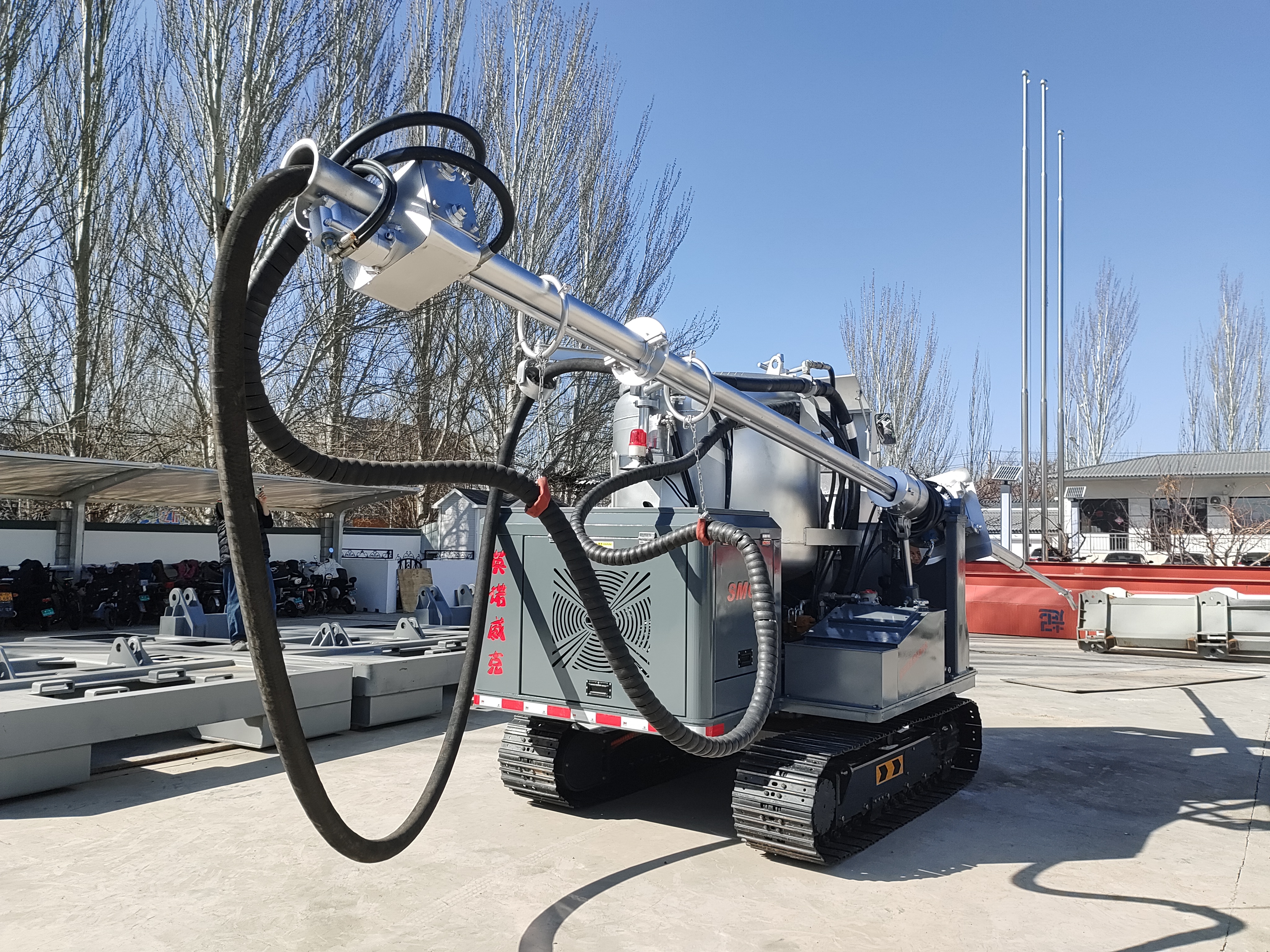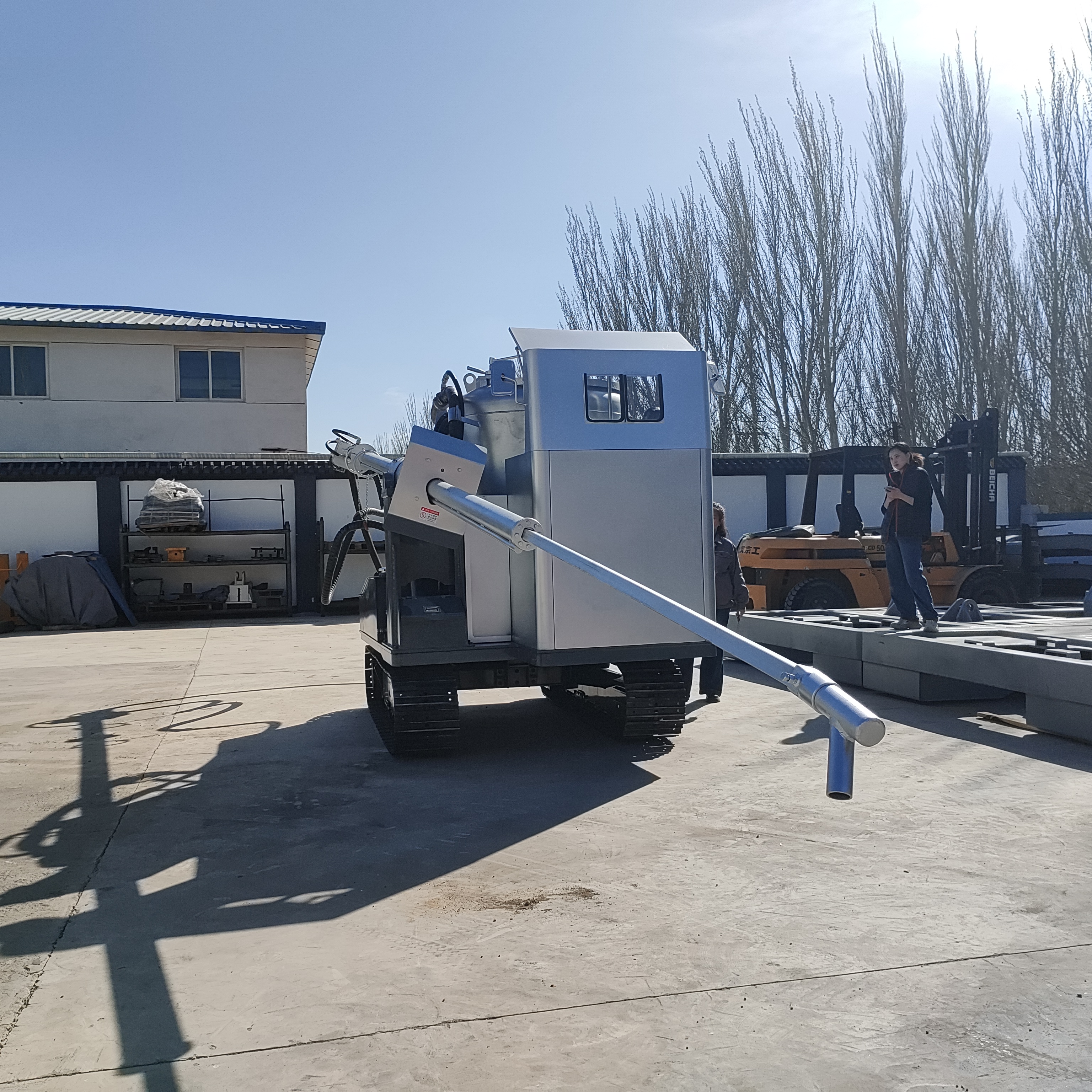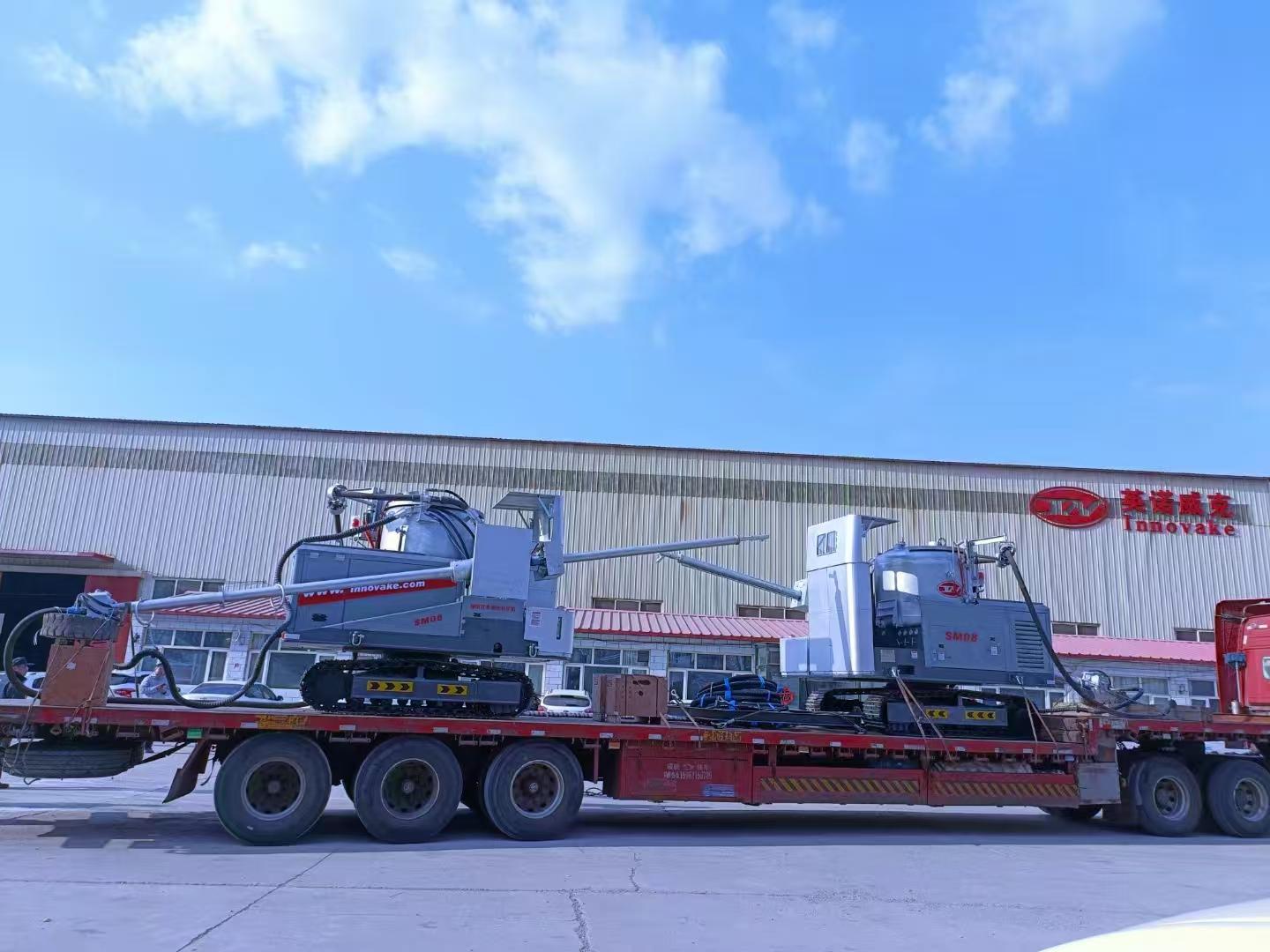Refractory Gunning Machines for Blast Furnace and Ladle in Steel Mill
1. Introduction
In the steelmaking industry, blast furnaces and ladles are fundamental pieces of equipment. Blast furnaces are responsible for the primary smelting process, reducing iron ore to molten iron, while ladles are used for transporting and holding the molten steel. However, both of these crucial components are exposed to extremely harsh conditions.
The refractory linings of blast furnaces endure high temperatures, often exceeding 1500°C, along with intense chemical reactions from the molten iron and slag, and mechanical abrasion due to the movement of raw materials. In ladles, the refractory linings face the erosive action of molten steel, thermal shock during charging and discharging, and chemical attack from slag. As a result, the refractory linings of blast furnaces and ladles are prone to wear and damage, which can lead to equipment failures, production interruptions, and safety hazards.
Refractory gunning machines have emerged as a key solution for maintaining and repairing the refractory linings of blast furnaces and ladles. By spraying refractory materials onto the damaged areas, these machines can effectively restore the integrity of the linings, extend their service life, and ensure the smooth operation of the steelmaking process.

2. Types of Refractory Gunning Machines
2.1 Wet - type Gunning Machines
Wet - type gunning machines are designed to spray a pre - mixed slurry of refractory materials and water. This slurry is pumped through a hose to the nozzle, where it is then sprayed onto the surface of the refractory lining that requires repair. In the context of blast furnaces, wet - type gunning machines can be used to apply a smooth coating on the inner walls of the furnace's upper shaft, where the temperature is relatively lower and a more homogeneous lining is beneficial for reducing gas flow resistance. For ladles, they can be used to repair the bottom lining, providing a protective layer against the direct impact of molten steel.
However, wet - type gunning machines have certain limitations. The water in the slurry can cause the refractory material to shrink during the drying process, potentially leading to cracking. In addition, transporting the wet slurry over long distances is more challenging compared to dry materials, which may limit their application in large - scale blast furnace complexes where the repair locations are far from the material preparation area.
2.2 Dry - type Gunning Machines
Dry - type gunning machines utilize compressed air to transport dry refractory powders to the nozzle. At the nozzle, water is added to the dry powder to form a semi - wet mixture that is then sprayed onto the repair surface. In blast furnace applications, dry - type gunning machines are highly suitable for repairing the hearth and bosh areas, which are exposed to high temperatures and severe wear. The dry powders can be quickly heated and adhered to the hot refractory lining, providing a strong and durable repair. For ladles, they are often used to repair the side walls, where the ability to handle a wide range of refractory materials is crucial due to the varying thermal and mechanical stresses.
Nevertheless, dry - type gunning machines may generate more dust during operation. In a steel mill environment, where air quality control is important for the health of workers and the proper functioning of other equipment, this requires the implementation of proper dust - collection measures, such as installing efficient dust collectors and ventilation systems.
2.3 Flame Gunning Machines
Flame gunning machines represent a more advanced form of refractory gunning equipment. They generate a high - temperature flame, typically by burning a fuel gas like propane or natural gas in the presence of oxygen, to heat and melt the refractory materials as they are being sprayed onto the repair surface. In blast furnaces, flame gunning machines are extremely effective for repairing the throat and stack areas, which are exposed to the highest temperatures and the most aggressive gas environments. The high - temperature flame can rapidly melt the refractory materials, enabling them to bond firmly to the existing lining, resulting in a robust and long - lasting repair. For ladles, they can be used to repair the critical areas near the pouring spout, where the refractory lining needs to withstand the high - velocity flow of molten steel.
However, flame gunning machines are more complex and expensive compared to wet - type and dry - type gunning machines. They demand careful operation and maintenance to ensure the safe and efficient use of the flame. Operators need to be highly trained to control the flame temperature, fuel - to - oxygen ratio, and the spraying process to achieve optimal results.
3. Working Principle of Refractory Gunning Machines
3.1 Material Conveyance
In wet - type gunning machines, the pre - mixed slurry is usually pumped through a hose using a positive - displacement pump. This pump is designed to provide a steady and consistent flow of the slurry to the nozzle. The choice of pump and the diameter of the hose are carefully selected based on the viscosity of the slurry and the distance it needs to be transported. For example, in a large - scale blast furnace repair project, a high - capacity positive - displacement pump may be used to ensure that the slurry reaches the upper parts of the furnace quickly and evenly.
In dry - type gunning machines, compressed air is the medium for transporting dry refractory powders. The powders are fed into a hopper and then carried by a high - velocity air stream through a hose to the nozzle. The air pressure and the diameter of the hose are precisely engineered to ensure that the powders are conveyed smoothly without blockages. In a steel mill with multiple blast furnaces and ladles, a central compressed air system may be used to supply the necessary air pressure for all dry - type gunning machines, with individual regulators at each machine to control the air flow rate according to the specific repair requirements.
In flame gunning machines, the refractory materials are conveyed by compressed air, similar to dry - type gunning machines. In addition, fuel gas and oxygen are supplied to the nozzle to generate the high - temperature flame. The supply of fuel gas and oxygen is carefully regulated to maintain the correct flame temperature and combustion efficiency. For instance, in a ladle repair operation, the fuel - to - oxygen ratio may be adjusted based on the type of refractory material being used and the thickness of the repair layer required.
3.2 Spraying Process
Once the refractory materials reach the nozzle, the spraying process begins. In wet - type gunning machines, the slurry is forced out of the nozzle by the pump pressure. The nozzle is designed to distribute the slurry evenly over the surface, forming a uniform coating. The shape and size of the nozzle are optimized to achieve the desired spraying pattern and coating thickness. For example, a flat - fan - shaped nozzle may be used for spraying large, flat areas in a ladle, while a cone - shaped nozzle may be more suitable for spraying curved surfaces in a blast furnace.
In dry - type gunning machines, at the nozzle, water is added to the dry powder through a water - injection system. The water - powder mixture is then sprayed out of the nozzle by the remaining kinetic energy of the air stream. The spraying angle and the distance from the nozzle to the repair surface are crucial parameters that need to be adjusted to ensure good adhesion and coverage. In a blast furnace repair, the operator may adjust the spraying angle to reach the damaged areas on the sloping walls of the furnace, while maintaining an appropriate spraying distance to prevent the materials from bouncing off the surface.
In flame gunning machines, the refractory materials are fed into the high - temperature flame at the nozzle. The flame heats and melts the materials, and the molten or semi - molten materials are then sprayed onto the surface. The high - temperature and high - velocity of the flame help the materials to bond strongly to the existing refractory lining. The operator needs to control the speed at which the materials are fed into the flame and the movement of the nozzle to ensure a consistent and high - quality repair. In a ladle repair near the pouring spout, the operator may move the nozzle in a circular motion to create a thick and uniform repair layer that can withstand the intense wear from the flowing molten steel.

4. Advantages of Using Refractory Gunning Machines in Steel Mills
4.1 Prolonging Equipment Service Life
By promptly repairing the worn - out parts of the refractory linings of blast furnaces and ladles with gunning machines, the overall integrity of the linings can be maintained. In blast furnaces, the constant impact of the descending burden and the erosive action of the hot gases can cause uneven wear on the refractory lining. Refractory gunning machines can be used to spray new refractory materials onto the worn areas, compensating for the material loss and restoring the thickness and performance of the lining. In ladles, the repeated exposure to molten steel and slag can lead to the erosion of the refractory lining. Regular use of gunning machines for repair can significantly extend the service life of the ladle refractory linings. Studies have shown that with proper use of refractory gunning machines, the service life of blast furnace refractory linings can be increased by 15 - 30%, and that of ladle refractory linings can be increased by 20 - 50%. This reduces the frequency of lining replacement and the associated costs.
4.2 Reducing Downtime
Compared with traditional methods of completely replacing the refractory lining, using refractory gunning machines for repair is much faster. In a blast furnace, if a small - to - medium - sized damage occurs in the refractory lining, using a gunning machine for repair may only take a few hours, while completely replacing the lining may require days or even weeks of downtime. In a steel mill where continuous production is crucial, minimizing downtime can significantly increase production efficiency. Reducing downtime not only means more steel can be produced in a given time period but also reduces the costs associated with idling equipment, such as energy consumption during standby and potential losses due to missed production schedules. For ladles, quick repairs using gunning machines can ensure that they are back in service promptly, maintaining the smooth flow of the steelmaking process.
4.3 Cost - savings
The use of refractory gunning machines brings significant cost - savings in several aspects. Firstly, as mentioned above, prolonging the service life of refractory linings reduces the frequency of lining replacement, saving the cost of purchasing new refractory materials and the labor cost for lining replacement. Secondly, reducing downtime means less loss of production revenue during equipment maintenance. Thirdly, some advanced refractory gunning machines can optimize the use of refractory materials, reducing material waste. For example, certain gunning machines are designed to achieve a lower rebound rate of refractory materials during spraying, which means more of the sprayed materials adhere to the repair surface, reducing the amount of materials needed for each repair. In a large - scale steel mill with multiple blast furnaces and ladles, these cost - savings can accumulate to a significant amount over time.
5. Factors Affecting the Performance of Refractory Gunning Machines
5.1 Refractory Material Properties
The properties of the refractory materials used in gunning machines, such as particle size distribution, chemical composition, and binding ability, have a significant impact on the performance of the gunning process. In blast furnace applications, if the particle size of the refractory material is too large, it may cause blockages in the conveying hose and nozzle, especially in the complex piping systems used to reach the various parts of the furnace. On the other hand, if the particle size is too small, the material may not have sufficient strength after spraying, leading to premature wear. The chemical composition of the refractory material should be compatible with the existing refractory lining to ensure good adhesion and chemical stability. For example, in a blast furnace lined with magnesia - based refractories, using an alumina - based refractory material for repair may not result in a strong bond. The binding ability of the refractory material determines how well it adheres to the repair surface and forms a strong and durable coating. Different types of refractory materials, such as alumina - based, magnesia - based, or silica - based, have different performance characteristics, and the choice of material should be based on the specific requirements of the blast furnace or ladle lining repair. In ladles, where the refractory lining needs to withstand the corrosive action of molten steel, a refractory material with high corrosion resistance and good binding properties should be selected.
5.2 Spraying Parameters
Spraying parameters, including the pressure of compressed air, the flow rate of refractory materials, and the spraying distance and angle, also play a crucial role in the performance of refractory gunning machines. In blast furnace repair, the pressure of compressed air needs to be carefully adjusted to ensure that the refractory materials are effectively conveyed to the nozzle and sprayed onto the repair surface with sufficient force. If the air pressure is too low, the materials may not be able to reach the target surface or may not adhere firmly, especially in the high - altitude areas of the furnace. If the air pressure is too high, it may cause excessive rebound of the materials and damage to the existing lining. The flow rate of refractory materials should be coordinated with the air pressure to achieve a uniform and stable spraying process. The spraying distance and angle should be optimized according to the shape and size of the repair area. In a ladle, the spraying distance and angle need to be adjusted to ensure that the refractory materials cover the entire damaged area evenly, especially in the corners and near the pouring spout.
5.3 Operator Skills
The skills and experience of the operators also affect the performance of refractory gunning machines. Skilled operators can better control the spraying parameters, adjust the position and movement of the gunning machine according to the actual situation of the repair area, and ensure the quality of the repair work. In a blast furnace, operators need to be able to navigate the complex internal structure of the furnace and accurately direct the gunning machine to the damaged areas. They can quickly identify and solve problems such as blockages in the conveying system or uneven spraying. In addition, operators with experience in different types of refractory repair work can make more appropriate choices of refractory materials and spraying methods based on the specific conditions of the blast furnace or ladle lining. Therefore, steel mills should invest in training and retaining skilled operators to ensure the optimal performance of refractory gunning machines.

6. Maintenance and Troubleshooting of Refractory Gunning Machines
6.1 Regular Maintenance
Regular maintenance is essential to ensure the normal operation of refractory gunning machines. This includes checking and cleaning the components of the machine regularly. For the refractory material storage bin, it should be cleaned regularly to prevent the accumulation of hardened materials, which can affect the feeding process. In blast furnace applications, where the refractory materials are often exposed to high - temperature and dusty environments, the storage bin may be more prone to material buildup. The conveying hoses and nozzles should be inspected for wear and blockages. Worn - out hoses and nozzles should be replaced in a timely manner to avoid affecting the spraying performance. In a steel mill with a high - volume production, the conveying hoses may experience more frequent wear due to the continuous flow of refractory materials. The compressed air system should also be maintained, including checking the air filter, lubricating the air compressor, and ensuring the normal operation of the pressure regulator. The electrical system of the machine, such as motors and control panels, should be checked for loose connections, short - circuits, and other electrical problems. Regular lubrication of moving parts, such as wheels (for mobile machines) and conveyor belts, can reduce wear and extend the service life of the machine.
6.2 Troubleshooting Common Problems
Blockages in the Conveying System: If there are blockages in the conveying hose or nozzle, it may be due to the agglomeration of refractory materials, oversized particles, or insufficient air pressure. In a blast furnace repair, where the refractory materials may be subject to high - temperature pre - heating, the agglomeration of materials can be more common. The solution is to first stop the machine, then carefully clear the blockage. If the blockage is caused by oversized particles, it is necessary to check the screening device for refractory materials and ensure that the particle size of the materials meets the requirements. Adjusting the air pressure to the appropriate value can also help solve the problem.
Low Spraying Efficiency: Low spraying efficiency may be caused by problems such as a decrease in air pressure, a clogged air compressor, or a malfunctioning feeding device. In a steel mill where multiple gunning machines are operating simultaneously, the air compressor may be overloaded, leading to a decrease in air pressure. Check the air compressor to ensure it is working properly and that the air pressure can reach the required value. Inspect the feeding device to make sure the refractory materials are fed smoothly. If necessary, clean or repair the feeding device.
Poor Adhesion of Refractory Materials: Poor adhesion may be due to improper spraying parameters, such as an incorrect spraying distance or angle, or inappropriate refractory material properties. In a ladle repair, if the surface of the repair area is not properly prepared, it can also lead to poor adhesion. Adjust the spraying parameters according to the actual situation, and ensure that the refractory materials used are suitable for the repair work. If the surface of the repair area is dirty or has oxide layers, it should be cleaned thoroughly before spraying to improve adhesion.

7. Future Development Trends of Refractory Gunning Machines
With the continuous progress of technology, future refractory gunning machines will move towards intelligence and automation. Intelligent control systems will be able to automatically adjust spraying parameters, such as the flow rate of refractory materials, the pressure of compressed air, and the spraying angle, based on the damage conditions of the refractory linings of blast furnaces and ladles. For example, sensors installed on the gunning machines can detect the thickness of the refractory lining, the temperature distribution, and the degree of wear in real - time. These data are then transmitted to the control system, which calculates the optimal spraying plan using preset algorithms and models and controls the gunning machine to execute the corresponding operations. Automation can reduce human intervention, improve the accuracy and consistency of spraying work, and at the same time reduce the labor intensity of operators. In large - scale steel mills, automated refractory gunning machines can work continuously and efficiently, improving production efficiency and reducing production costs.



